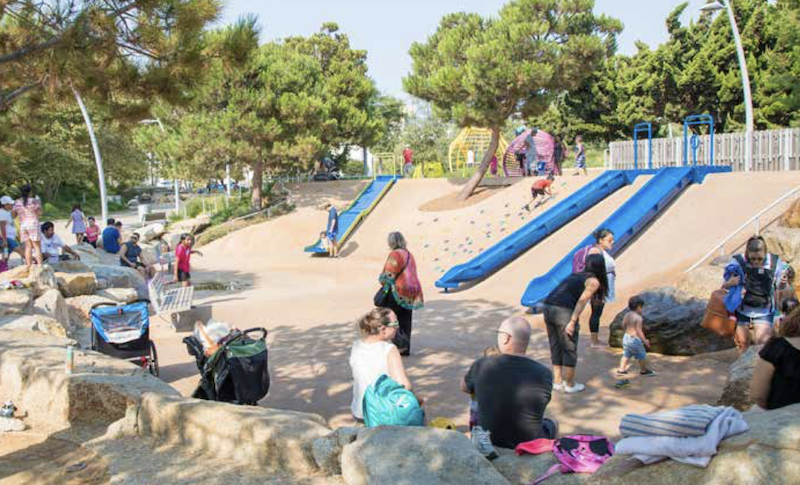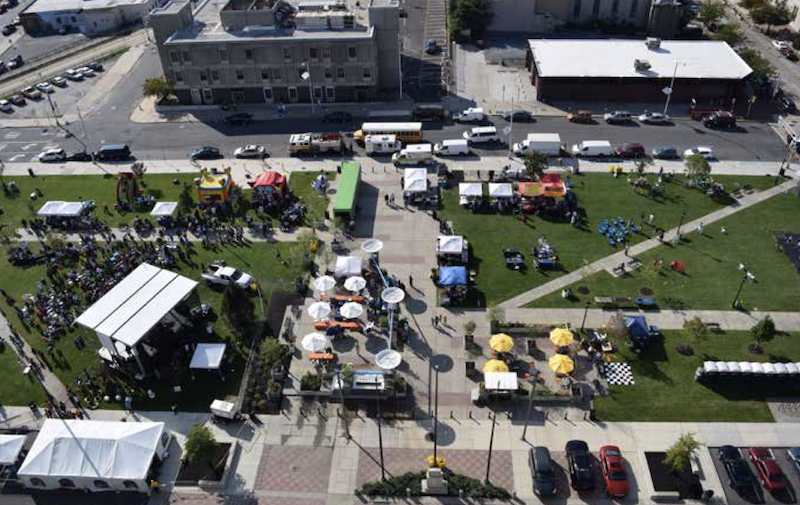A few years ago, in his book “Parking and the City,” Donald Shoup, distinguished research professor of urban planning at UCLA’s Luskin School of Public Affairs, estimated that there were eight parking spaces for every vehicle that was on the road in the U.S.
Other research also shows that one in three Americans doesn’t have a park within a 10-minute walk from his or her home.
With the number of automobile registrations down, and with ride-sharing continuing to gain customers—Uber fulfills more than 40 million rides per month in the U.S.; Lyft’s domestic ridership rose from 3.5 million in the first quarter of 2016 to 21.2 million in the first quarter of 2020—American cities “are rethinking the primacy of the car and are creating parks on land once dedicated to the automobile, including former parking lots and roadways, parking garages, and spaces underneath highway overpasses.”
That’s from “Pavements to Parks,” a new report published by the Urban Land Institute’s Building Healthy Places Initiative. The report provides conversion case studies on 15 projects and four municipal programs. ULI collaborated with 10 Minute Walk, a movement dedicated to improving access to safe, high-quality parks and green spaces in the U.S. That organization’s goal is to create a world in which, by 2050, all people live within a short walk of a park or green space.
CREATING A POSITIVE ENVIRONMENTAL AND HEALTH IMPACT
Transforming space designed for vehicles to public-use space has had its successes. For example, over 24,000 miles of railroad tracks have been converted to walking trails. The ULI report states that trail advocates announced in the spring of 2019 an initiative to create a coast-to-coast recreational trail, which would connect more than 125 existing trails nationwide.
The coronavirus outbreak has contributed to this pavement-to-parks trend, states ULI, by underscoring the importance of abundant and safe parks. “To provide space for physically distanced recreation, dining, and transportation, many cities are temporarily or permanently closing streets, parking lots, and other public infrastructure assets.”
Paved parking lots and roadways are also being reexamined for their impact on human and environmental health, especially how stormwater runoff picks up contaminants that end up in waterways.
The impetus behind park transformation can emanate from many sources, like the organic community engagement that helped create Chicano Park, a national landmark in San Diego; the drive of a visionary leader as at Norman B. Leventhal Park in Boston’s Financial District; or the determination of a city planning department as in Dutch Kills Green and the Queensboro Bridge Greenway in Queens, N.Y. “Regardless of the spark, the ability to look at an automobile-oriented place and see the possibilities for a greener, healthier, and more sustainable future is essential,” ULI states.
Collaboration in these endeavors is key. The report points to the birth of Roosevelt Plaza Park in Camden, N.J., which required leadership from the city and the redevelopment authority, as well as ongoing leadership from Cooper’s Ferry Partnership, a private nonprofit redevelopment corporation. “When many stakeholders are involved, it is important for partners’ unique expertise and priorities to be understood and respected,” says ULI.
Roosevelt Plaza Park replaced a building that included a parking garage, office space, and ground-floor retail. The building was condemned in 2003 and demolished eight years later. The space—which is located at the front door of City Hall—was reopened as a plaza in 2012.

Pop-up and semipermanent installations attract people to Roosevelt Plaza Park. Image: Cooper's Ferry Partnership
The Camden Redevelopment Agency constructed the 1.5-acre park with Cooper’s Ferry Partnership. Two years later, a series of pop-up and semi-permanent installations and rotating programming created a flexible changeable model to attract parkgoers. And a partnership of Camden stakeholders stepped in to ensure that its ongoing programing would make it a safe and welcoming space for all residents.
Group Melvin Design and Sikora Wells Appel were the designers on this $9 million project.
COMMUNITY INVOLVEMENT IN DESIGN
Data collection was essential in the case of Philadelphia’s Porch at 30th Street, where project developers had to come up with a variety of programming to engage new stakeholders—including Amtrak employees and riders—with activities and amenities that met their needs.
Programming and flexibility play big roles in any transformation, too. For example, Klyde Warren Park in Dallas hosts 1,300 events per year, ranging from large receptions and concerts to children’s bilingual storytelling. And transformations must have the support of its local community. Throughout the design process for Tongva Park in Santa Monica, Calif., five workshops engaged over 200 community members and helped inform both the design for the park and the name selected.

Tongva Park in Santa Monica, Calif., replaced surface parking. Over 200 members of the local community participated in five design workshops for this project. Image: City of Santa Monica
This 2.4-acre green space, formerly the site of the Rand Corporation headquarters (which was razed in the 1990s), had been used as a surface parking lot. Construction of the park began 2012, and was completed October 2013 at a cost of $42.3 million, paid for by city of Santa Monica. The community was engaged extensively during the initial design phase; 200 people showed up to the first of five community workshops, held on the empty site. Through the workshops, the landscape architect selected to lead the project—James Corner Field Operations— presented alternatives, residents provided feedback, and the final plan was a park designed with four hills and views of the ocean that did not exist previously.
Working in collaboration, the city’s public works department maintains the Tongva Park, and the community and cultural services department spearheaded by the cultural affairs division
is responsible for programming. The annualized cost to maintain the park by public works is about $300,000, not accounting for utility costs. Now that the park is established, every three years an additional expenditure of $25,000 is allocated for tree trimming. Although the park was initially built in an area that was relatively devoid of residents, a mixed-use housing project completed in 2014—with 318 units of for-sale condominiums and affordable rental apartments—sits adjacent to the park.
A PROGRAMMATIC SOLUTION
One of the ongoing parking-to-parks programs that ULI singles out is the nonprofit Depave, in Portland, Ore., which focuses on the removal of impervious pavements to eliminate stormwater runoff and pollution and the creation of more space for urban agriculture, trees, native vegetation, green infrastructure, wildlife habitats, and recreation and social activities.

Inukai Boys and Girls Club in Hillsboro, Ore., which Depave converted from a 4,500-sf parking lot. Image: Katya Reyna, Depave
Depave partners with schools, churches, and community-based organizations that primarily serve low-income people and people of color, often in historically redlined and disenfranchised communities in Portland. Its volunteer and community partners implement conversion projects such as:
•Transforming a 4,500-sf parking lot at Inukai Family Boys and Girls Club in Hillsboro, Ore., into a nature play area with an educational rain garden for 200 children;
•Ripping up 1,700 sf of asphalt from an oversized parking lot at Plaza 122, a community investment trust commercial center in Portland, to make way for rain gardens and trees; and
Removing a total of 12,000 sf of asphalt from three Title 1 elementary schools in the Centennial School District, which serves Gresham and southeast Portland, replacing it with nature play areas, educational rain gardens, and native plants.
Related Stories
Performing Arts Centers | Oct 21, 2024
The New Jersey Performing Arts Center breaks ground on $336 million redevelopment of its 12-acre campus
In Newark, N.J., the New Jersey Performing Arts Center (NJPAC) has broken grown on the three-year, $336 million redevelopment of its 12-acre campus. The project will provide downtown Newark 350 mixed-income residential units, along with shops, restaurants, outdoor gathering spaces, and an education and community center with professional rehearsal spaces.
Performing Arts Centers | Oct 10, 2024
Studio Gang's performing arts center for Hudson Valley Shakespeare breaks ground
A new permanent home for Hudson Valley Shakespeare, a professional non-profit theater company, recently broke ground in Garrison, N.Y. The Samuel H. Scripps Theater Center includes a 14,850 sf performance venue that will serve as a permanent home for the theater company known for its sweeping open-air productions of classics and new works.
Museums | Oct 1, 2024
UT Dallas opens Morphosis-designed Crow Museum of Asian Art
In Richardson, Tex., the University of Texas at Dallas has opened a second location for the Crow Museum of Asian Art—the first of multiple buildings that will be part of a 12-acre cultural district. When completed, the arts and performance complex, called the Edith and Peter O’Donnell Jr. Athenaeum, will include two museums, a performance hall and music building, a grand plaza, and a dedicated parking structure on the Richardson campus.
Museums | Aug 29, 2024
Bjarke Ingels' Suzhou Museum of Contemporary Art conceived as village of 12 pavilions
The 60,000-sm Suzhou Museum of Contemporary Art in Suzhou, Jiangsu, China recently topped out. Designed by Bjarke Ingels Group (BIG), the museum is conceived as a village of 12 pavilions, offering a modern interpretation of the elements that have defined the city’s urbanism, architecture, and landscape for centuries.
Cultural Facilities | Aug 21, 2024
Baltimore’s National Aquarium opens 10,000-sf floating wetland that mimics the harbor’s original tidal marsh habitat
The National Aquarium in Baltimore has opened the National Aquarium Harbor Wetland, a 10,000-sf floating wetland that mimics the Inner Harbor’s original Chesapeake Bay tidal marsh habitat. Located between Piers 3 and 4 on Baltimore’s Inner Harbor, the $14 million project features more than 32,000 native shrubs and marsh grasses.
Museums | Aug 19, 2024
The Tampa Museum of Art will soon undergo a $110 million expansion
In Tampa, Fla., the Tampa Museum of Art will soon undergo a 77,904-sf Centennial Expansion project. The museum plans to reach its $110 million fundraising goal by late 2024 or early 2025 and then break ground. Designed by Weiss/Manfredi, and with construction manager The Beck Group, the expansion will redefine the museum’s surrounding site.
Smart Buildings | Jul 25, 2024
A Swiss startup devises an intelligent photovoltaic façade that tracks and moves with the sun
Zurich Soft Robotics says Solskin can reduce building energy consumption by up to 80% while producing up to 40% more electricity than comparable façade systems.
Adaptive Reuse | Jul 12, 2024
Detroit’s Michigan Central Station, centerpiece of innovation hub, opens
The recently opened Michigan Central Station in Detroit is the centerpiece of a 30-acre technology and cultural hub that will include development of urban transportation solutions. The six-year adaptive reuse project of the 640,000 sf historic station, created by the same architect as New York’s Grand Central Station, is the latest sign of a reinvigorating Detroit.
Museums | Jun 20, 2024
Connecticut’s Bruce Museum more than doubles its size with a 42,000-sf, three-floor addition
In Greenwich, Conn., the Bruce Museum, a multidisciplinary institution highlighting art, science, and history, has undergone a campus revitalization and expansion that more than doubles the museum’s size. Designed by EskewDumezRipple and built by Turner Construction, the project includes a 42,000-sf, three-floor addition as well as a comprehensive renovation of the 32,500-sf museum, which was originally built as a private home in the mid-19th century and expanded in the early 1990s.
Libraries | Jun 7, 2024
7 ways to change 'business as usual': The Theodore Roosevelt Presidential Library
One hundred forty years ago, Theodore Roosevelt had a vision that is being realized today. The Theodore Roosevelt Presidential Library is a cutting-edge example of what’s possible when all seven ambitions are pursued to the fullest from the beginning and integrated into the design at every phase and scale.

















